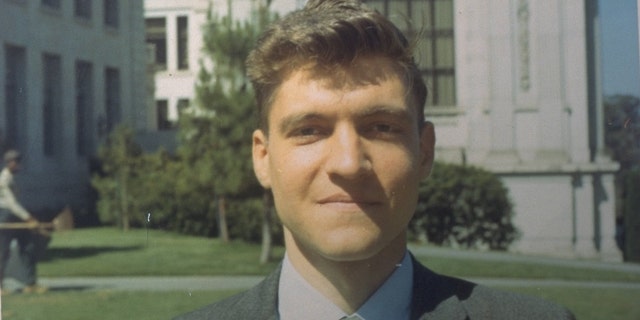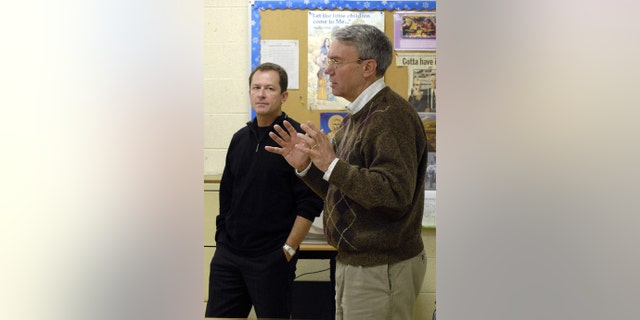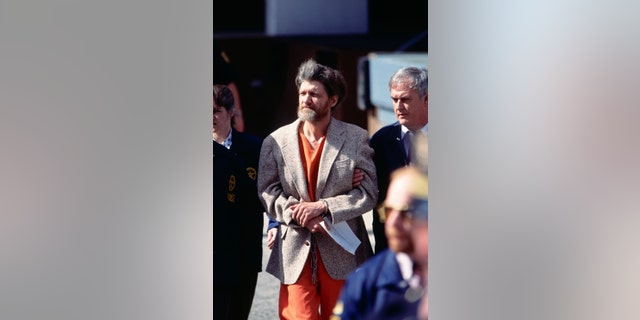NEWYou can now listen to Fox News articles!
Linda Patrik always believed there was something off about her brother-in-law, Ted Kaczynski, the Montana recluse who would be known as the Unabomber.
When Kaczynski learned of his brother, David’s, impending nuptials, he quickly wrote a series of scathing letters criticizing the bride-to-be despite never meeting her. Patrik suspected he was struggling with mental health issues and voiced her concerns to David.
And it was Patrik who first suspected that Kaczynski was behind what would become one of the most exhaustive manhunts in FBI history.
Ted Kaczynski, also known as the Unabomber, is chronicled in an Apple original true-crime podcast titled “Project Unabom.”
(Photo by Bureau of Prisons/Getty Images)
The story of the domestic terrorist who was convicted of killing three people and injuring 23 with 16 bombs is chronicled in an Apple original true-crime podcast titled “Project Unabom.” The series, which concludes Monday, explores how Kaczynski terrorized a nation for nearly a decade, as well as how he was finally captured.

Apple’s true-crime podcast ‘Project Unabomb’ explores the case of Ted Kaczynski
(Apple)
“David’s wife is the one who really connected the dots, and she had never met Kaczynski,” retired FBI Special Agent Molly Flynn told Fox News Digital. “Ted exchanged letters with his brother for years. She read some of those letters or at least had discussions with her husband about them. But she was tuned into the notion that there was something wrong with him. Again, she never met him. But there was something about those letters that compelled her to say, ‘We need to address this.’ This wasn’t out of any spite or vengeance. It was out of genuine concern. So, we need to give her a lot of credit.”
Patrik’s concerns deepened after the Unabomber’s manifesto was published in The Washington Post. She recognized similar words and even phrases Kaczynski had used in his letters. Her brother-in-law quickly came to mind.
Flynn, as well as fellow retired FBI Special Agent Kathy Puckett, shared their accounts concerning the investigation in the podcast. Puckett described how if it weren’t for Patrik spotting those red flags, chances are the Kaczynski case could have remained unsolved.
“Bombers are tough in general because if their bombs are successful at exploding, the evidence is destroyed,” she said. “But in this case, he didn’t leave a single fingerprint or clue of his actual location. Meanwhile, he was in Montana the whole time. We never suspected Montana. … He was very, very careful. Nobody had ever seen anybody this careful.”
CLICK HERE TO SIGN UP FOR THE ENTERTAINMENT NEWSLETTER

Archival photo of American mathematician and professor Ted Kaczynski, later a domestic terrorist known as the Unabomber, as he poses outdoors at the University of California, Berkeley, June 1968.
(Sygma/Sygma via Getty Images)
“I remember the most startling thing when I went through his manifesto,” Puckett continued. “He wrote about how he picked up a hair in a bathroom at the University of Utah and put it under the tape of the device that he left, hoping it would detonate. We found it at the doorway of one of the classrooms in that building. And it was found with a red hair. So for a long time, we thought, ‘We’ve got a hair. It might be from the Unabomber.’ It was the only thing we had to go on for years. We had no leads. We had nothing to go on. Usually, bombers have a connection with their victims. They’re angry. They leave traces of their passage through society. But he didn’t. He left nothing for us.”
Kaczynski, a Harvard-trained mathematician, had given up a promising academy career to carry out mail bombings to express his belief that technology was the true evil of society. The nationwide manhunt for him spanned 17 years, making it one of the longest and most expensive criminal investigations in FBI history.
“When it comes to the so-called lone wolf or people who act on their own, it’s not as cut and dry,” Puckett explained. “These people are very alienated from society. What’s happened in the last 20 years or so is that people who normally can’t make meaningful connections with others can try to do that now on the internet. So, they don’t have to put themselves out in society anywhere. They can make a fake name, go online and join these groups where they can develop relationships with people who are just as guarded as they are. As a result, they radicalize each other. The internet is a huge difference. … But Ted didn’t have that when he was doing his bombings.”
“He would go to this tiny library in Lincoln, Montana, and read newspapers,” she said. “He had no power in his cabin. He had no running water. He was isolated. But he was a voracious reader. The manifesto came from his readings and ideals that he got over the years. … That’s the reason we got him. We knew somebody out there was going to recognize him by his words alone. And that’s what happened.”

Front pages of the New York Times and Washington Post — both outlets published a manifesto written by the domestic terrorist known as the Unabomber on Sept. 19, 1995. The entire 35,000 word manifesto was published in response to a demand made by the Unabomber, later revealed to be Ted Kaczynski, who had threatened to kill again if his entire philosophy was not printed.
( Luke Frazza/AFP via Getty Images)
In September 1995, The Washington Post in conjunction with The New York Times published his anti-technology manifesto, “Industrial Society and Its Future.” The manifesto was printed at the urging of federal authorities after the bomber said he would desist from terrorism if a national publication published his treatise.
After recognizing Kaczynski’s handwriting in his manifesto, Patrik showed it to David who also identified the handwriting as his brother’s. The couple was “troubled enough,” said Puckett, and the pair notified the FBI.
“Ted’s mother, Wanda, was very aggrieved that her son was so alienated,” said Puckett. “She was very worried about him for so many years. She always supported him. She even financially supported him for a bit — just a couple hundred dollars a year. But the family was just devastated to find out that some of the money they had given him over the years was used to buy supplies for his bombs. But the family spoke out because they wanted this to stop. David and his wife, Linda, in particular, are devout Buddhists. So for them, life was very precious. The fact that a member of their family killed and terrorized people for so many years without being caught just devastated them. They simply thought his behavior was a result of mental illness.”
“He never saw us coming,” Puckett added.

FBI agents guard the entrance to the property of Ted Kaczynski near Lincoln, Montana, on April 5, 1996.
(John Ruthroff/AFP via Getty Images)
On April 3, 1996, Kaczynski was arrested in a primitive cabin 75 miles east of Missoula, Montana. Kaczynski was described as an unkempt loner in the sleepy mountain town who ate rabbits, lived without power and rode his bike to the town’s library. At the time of his arrest, Kaczynski had two completed bombs, explosive ingredients, journals and a coded diary.
Kaczynski, now 80, is serving life without the possibility of parole. He pleaded guilty to setting 16 explosions in various parts of the country between 1978 and 1995.
The deadly homemade bombs that the vengeful Kaczynski sent by mail — including an altitude-triggered explosion that went off as planned on an American Airlines flight — changed the way Americans sent packages and boarded airplanes.
A 1995 threat to blow up a plane out of Los Angeles before the end of the July 4 weekend threw air travel and mail delivery into chaos. The Unabomber later claimed it was a “prank.” The FBI dubbed him the “Unabomber” because his early targets seemed to be universities and airlines.

David Kaczynski, right, brother of the Unabomber, Ted Kaczynski, and Gary Wright, a Unabomber victim, speak to students in a classroom in Troy, New York, April 17, 2007.
(Tim Roske/Chicago Tribune/Tribune News Service via Getty Images)
Kaczynski hated the idea of being viewed as mentally ill and during his trial tried to fire his attorneys when they wanted to mount an insanity defense. He eventually pleaded guilty rather than let his attorneys proceed.
In his journals released at trial by the government at the request of the victims’ families, Kaczynski described his motive as “simply personal revenge.”
“I often had fantasies of killing the kind of people I hated — i.e., government officials, police, computer scientists, the rowdy type of college students who left their beer cans in the arboretum, etc., etc., etc.,″ he wrote.
Kaczynski killed computer rental store owner Hugh Scrutton, advertising executive Thomas Mosser and timber industry lobbyist Gilbert Murray. California geneticist Charles Epstein and Yale University computer expert David Gelernter were maimed by bombs two days apart in June 1993.
CASEY ANTHONY WANTS TO ‘TELL HER TRUTH’ IN A DOCUMENTARY, PAL SAYS: ‘SHE FEELS LIKE IT’S TIME’

Police officers bring Ted Kaczynski, aka the Unabomber, to court for arraignment, April 4, 1996. Kaczynski later pled guilty to the mail bomb attacks that killed three people and injured 23.
(Ralf-Finn Hestoft/CORBIS/Corbis via Getty Images)
There are lessons still to be learned from the Unabomber case years after it was solved.
“There are other people who have faced situations where maybe they have a friend or family member and you think something might be wrong with them,” said Flynn. “I think it’s really important to pay attention. Whether it’s a psychological issue or something else, it’s important to address something if it doesn’t feel right. In this case, we had Linda, who really paid attention and was a good communicator at that.”
“And don’t underestimate women,” Puckett added.
The Associated Press contributed to this report.